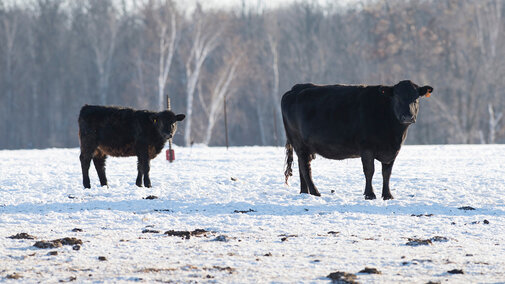Winter Cold and Insect Mortality
By Samantha DanielWith the recent bitterly cold temperatures across Nebraska, producers may be wondering if overwintering insect pests could be killed and their populations reduced. Although we’ve seen temperatures in the single or negative digits with wind chills reaching -30°F or lower, insects have adapted to survive winter’s chill.
Many of our most significant pests like western bean cutworm and western corn rootworm spend the winter below the soil surface. While soil temperature is dependent on many factors, it generally does not fluctuate significantly, even during extreme cold snaps. Soil that is covered by crop residue or snow will be further protected from bitter air temperatures. This means that the insects overwintering below ground are protected as well.
Insects that overwinter in more exposed areas have additional cold adaptations. For example, soybean aphids overwinter as eggs and supercool to temperatures as low as -29°F while European corn borer larvae can produce glycerol — a substance which acts as a biological antifreeze.
Additionally, keep in mind that not all our insect pests overwinter in Nebraska. Several species including the fall armyworm, black cutworm and corn earworm spend the winter in warmer climates and migrate to Nebraska during the growing season.
Even though insect pest populations will undoubtedly survive this period of extreme cold, remember that beneficial insects like parasitoids and natural predators will survive too.
Winter Water Needs
By Ben BeckmanAs the snow flies this winter, keeping a herd well-watered gets a bit harder. Power outages, frozen tanks and massive drifts can be roadblocks to a steady water source during cold temperatures. It might be tempting at these times to let animals fend for themselves — after all, snow has water, right?
First, we need to consider how much water animals need. As a rule of thumb, a dry cow or bull needs one gallon of water per 100 lbs. of body weight on an average day. Growing animals will require more. Lactating animals are usually near the top for need with two gallons of water daily per 100 lbs. of body weight.
Often, some of an animal’s water comes from its diet, but without fresh forage, almost all water needs must be met elsewhere. This means a cow needs to consume 30-40 lbs. of snow daily to meet its needs. When snow is crusted or trampled, consuming an appropriate amount is even more difficult.
The animal itself must also be considered. Eating snow is a learned behavior and doesn’t just happen overnight. Having an experienced cow in the herd to teach others can help, but animals new to the technique can still take up to a week to learn. Additionally, thin cattle (body condition score of three or less) should not be forced to depend only on snow. Cattle should have at least a BCS of four and should be in good health.
While water demands in the winter may be less than summer, keeping water available can be difficult. Having animals eat snow may be tempting but requires an experienced herd, plenty of fresh snow and healthy animals.

